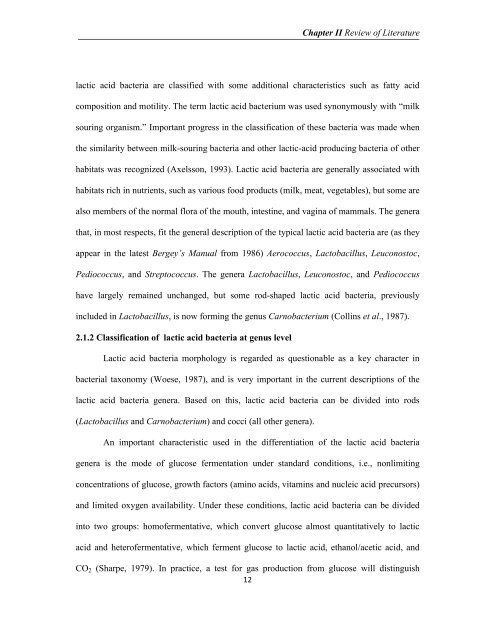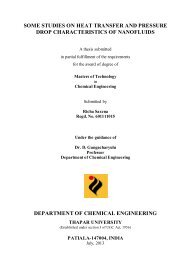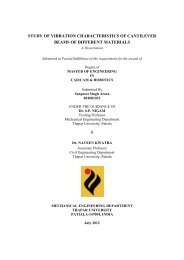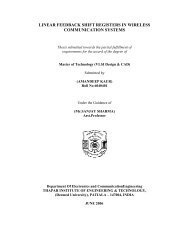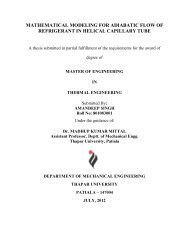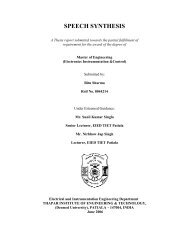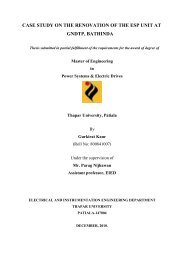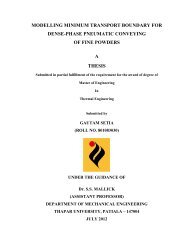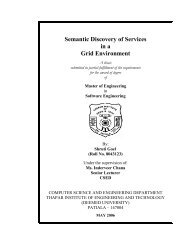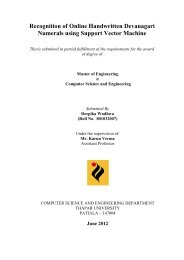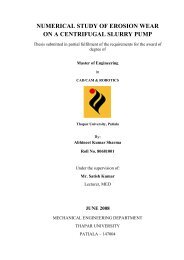from indigenous fermented foods and human gut ... - Thapar University
from indigenous fermented foods and human gut ... - Thapar University
from indigenous fermented foods and human gut ... - Thapar University
Create successful ePaper yourself
Turn your PDF publications into a flip-book with our unique Google optimized e-Paper software.
Chapter II Review of Literature<br />
lactic acid bacteria are classified with some additional characteristics such as fatty acid<br />
composition <strong>and</strong> motility. The term lactic acid bacterium was used synonymously with “milk<br />
souring organism.” Important progress in the classification of these bacteria was made when<br />
the similarity between milk-souring bacteria <strong>and</strong> other lactic-acid producing bacteria of other<br />
habitats was recognized (Axelsson, 1993). Lactic acid bacteria are generally associated with<br />
habitats rich in nutrients, such as various food products (milk, meat, vegetables), but some are<br />
also members of the normal flora of the mouth, intestine, <strong>and</strong> vagina of mammals. The genera<br />
that, in most respects, fit the general description of the typical lactic acid bacteria are (as they<br />
appear in the latest Bergey’s Manual <strong>from</strong> 1986) Aerococcus, Lactobacillus, Leuconostoc,<br />
Pediococcus, <strong>and</strong> Streptococcus. The genera Lactobacillus, Leuconostoc, <strong>and</strong> Pediococcus<br />
have largely remained unchanged, but some rod-shaped lactic acid bacteria, previously<br />
included in Lactobacillus, is now forming the genus Carnobacterium (Collins et al., 1987).<br />
2.1.2 Classification of lactic acid bacteria at genus level<br />
Lactic acid bacteria morphology is regarded as questionable as a key character in<br />
bacterial taxonomy (Woese, 1987), <strong>and</strong> is very important in the current descriptions of the<br />
lactic acid bacteria genera. Based on this, lactic acid bacteria can be divided into rods<br />
(Lactobacillus <strong>and</strong> Carnobacterium) <strong>and</strong> cocci (all other genera).<br />
An important characteristic used in the differentiation of the lactic acid bacteria<br />
genera is the mode of glucose fermentation under st<strong>and</strong>ard conditions, i.e., nonlimiting<br />
concentrations of glucose, growth factors (amino acids, vitamins <strong>and</strong> nucleic acid precursors)<br />
<strong>and</strong> limited oxygen availability. Under these conditions, lactic acid bacteria can be divided<br />
into two groups: homofermentative, which convert glucose almost quantitatively to lactic<br />
acid <strong>and</strong> heterofermentative, which ferment glucose to lactic acid, ethanol/acetic acid, <strong>and</strong><br />
CO2 (Sharpe, 1979). In practice, a test for gas production <strong>from</strong> glucose will distinguish<br />
12


